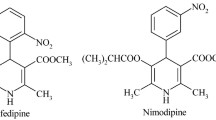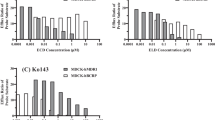Abstract
Background and Objectives
P-glycoprotein (P-gp) has been shown previously to contribute to the intestinal absorption of verapamil, diltiazem, tacrolimus, colchicine and indinavir in situ; however, its contribution in vivo is unknown. The present study aimed to evaluate the in vivo involvement of P-gp using elacridar as its inhibitor to distinguish the contribution of P-gp from cytochrome P450 (CYP) 3A.
Methods
Fexofenadine (5 mg/kg) and buspirone (1 mg/kg) were used as probe substrates of P-gp and CYP3A, respectively. Each dual substrate (1 or 2 mg/kg) was orally administered to rats after elacridar pre-treatment (3 mg/kg). Additionally, verapamil, diltiazem or tacrolimus was orally co-administered with fexofenadine.
Results
Elacridar drastically increased the area under the plasma concentration–time curve (AUC0–t) of oral fexofenadine by 8.6-fold; however, it did not affect the AUC0–t of oral buspirone. Therefore, elacridar inhibited P-gp without affecting CYP3A. The absorption of oral verapamil, diltiazem and tacrolimus was not influenced by elacridar pre-treatment, and the increase in the AUC0–t of fexofenadine was approximately 3-fold when co-administered with each substrate; the minimal effect of elacridar was attributable to the limited contribution of P-gp but not to their self-inhibition against the transporter. Conversely, elacridar significantly increased the AUC0–t of colchicine (5.3-fold) and indinavir (2.0-fold), indicating that P-gp contributes to their absorption.
Conclusions
Elacridar is useful for distinguishing the contribution of P-gp from CYP3A to the absorption of drugs in rats. The in vivo contribution of P-gp is minimal for high permeable compounds owing to their fraction absorbed of nearly 1.0.




Similar content being viewed by others
References
Misaka S, Miyazaki N, Yatabe M, Ono T, Shikama Y, Fukushima T, et al. Pharmacokinetic and pharmacodynamic interaction of nadolol with itraconazole, rifampicin and grapefruit juice in healthy volunteers. J Clin Pharmacol. 2013;53(7):738–45.
Bedada S, Sudhakar Y, Neerati P. Resveratrol enhances the bioavailability of fexofenadine in healthy human male volunteers: involvement of P-glycoprotein inhibition. J Bioequiv Bioavailab. 2014;6(5):158–63.
Miyazaki N, Misaka S, Ogata H, Fukushima T, Kimura J. Effects of itraconazole, dexamethasone and naringin on the pharmacokinetics of nadolol in rats. Drug Metab Pharmacokinet. 2013;28(4):356–61.
Bedada S, Yellu N, Neerati P. Effect of resveratrol on the pharmacokinetics of fexofenadine in rats: involvement of P-glycoprotein inhibition. Pharmacol Rep. 2016;68(2):338–43.
Zakeri-Milani PH, Islambulchilar Z, Damani S, Mehtari M. Investigation of the intestinal permeability of ciclosporin using the in situ technique in rats and the relevance of P-glycoprotein. Arzneimittelforschung. 2008;58(4):188–92.
Tamura S, Ohike A, Ibuki R, Amidon G, Yamashita S. Tacrolimus is a class II low-solubility high-permeability drug: the effect of P-glycoprotein efflux on regional permeability of tacrolimus in rats. J Pharm Sci. 2002;91(3):719–29.
Mitra P, Audus K, Williams G, Yazdanian M, Galinis D. A comprehensive study demonstrating that p-glycoprotein function is directly affected by changes in pH: implications for intestinal pH and effects on drug absorption. J Pharm Sci. 2011;100(10):4258–68.
Athukuri B, Neerati P. Enhanced oral bioavailability of diltiazem by the influence of gallic acid and ellagic acid in male wistar rats: involvement of CYP3A and P-gp inhibition. Phytother Res. 2017;31(9):1441–8.
Sandström R, Karlsson A, Lennernäs H. The absence of stereoselective P-glycoprotein-mediated transport of R/S-verapamil across the rat jejunum. J Pharm Pharmacol. 1998;50(7):729–35.
Ho Y, Huang D, Hsueh W, Lai M, Yu H, Tsai T. Effects of St. John’s wort extract on indinavir pharmacokinetics in rats: differentiation of intestinal and hepatic impacts. Life Sci. 2009;85(7–8):296–302.
Kadono K, Koakutsu A, Naritomi Y, Terashita S, Tabata K, Teramura T. Comparison of intestinal metabolism of CYP3A substrates between rats and humans: application of portal-systemic concentration difference method. Xenobiotica. 2014;44(6):511–21.
Matsuda Y, Konno Y, Hashimoto T, Nagai M, Taguchi T, Satsukawa M, et al. Quantitative assessment of intestinal first-pass metabolism of oral drugs using portal-vein cannulated rats. Pharm Res. 2015;32(2):604–16.
Mitschke D, Reichel A, Fricker G, Moenning U. Characterization of cytochrome P450 protein expression along the entire length of the intestine of male and female rats. Drug Metab Dispos. 2008;36(6):1039–45.
Lévesque J, Bleasby K, Chefson A, Chen A, Dubé D, Ducharme Y, et al. Impact of passive permeability and gut efflux transport on the oral bioavailability of novel series of piperidine-based renin inhibitors in rodents. Bioorg Med Chem Lett. 2011;21(18):5547–51.
Liu H, Sun H, Wu Z, Zhang X, Wu B. P-glycoprotein (P-gp)-mediated efflux limits intestinal absorption of the Hsp90 inhibitor SNX-2112 in rats. Xenobiotica. 2014;44(8):763–8.
Yang J, Milton M, Yu S, Liao M, Liu N, Wu J, et al. P-glycoprotein and breast cancer resistance protein affect disposition of tandutinib, a tyrosine kinase inhibitor. Drug Metab Lett. 2010;4(4):201–12.
Zhang D, Frost C, He K, Rodrigues A, Wang X, Wang L, et al. Investigating the enteroenteric recirculation of apixaban, a factor Xa inhibitor: administration of activated charcoal to bile duct-cannulated rats and dogs receiving an intravenous dose and use of drug transporter knockout rats. Drug Metab Dispos. 2013;41(4):906–15.
Ward K, Azzarano L. Preclinical pharmacokinetic properties of the P-glycoprotein inhibitor GF120918A (HCl salt of GF120918, 9,10-dihydro-5-methoxy-9-oxo-N-[4-[2-(1,2,3,4-tetrahydro-6,7-dimethoxy-2-isoquinolinyl)ethyl]phenyl]-4-acridine-carboxamide) in the mouse, rat, dog, and monkey. J Pharmacol Exp Ther. 2004;310(2):703–9.
Yamamoto S, Kosugi Y, Hirabayashi H, Moriwaki T. Impact of P-Glycoprotein on intestinal absorption of an Inhibitor of apoptosis protein antagonist in rats: mechanisms of nonlinear pharmacokinetics and food effects. Pharm Res. 2018;35(10):190.
Kamath A, Yao M, Zhang Y, Chong S. Effect of fruit juices on the oral bioavailability of fexofenadine in rats. J Pharm Sci. 2005;94(2):233–9.
Cvetkovic M, Leake B, Fromm M, Wilkinson G, Kim R. OATP and P-glycoprotein transporters mediate the cellular uptake and excretion of fexofenadine. Drug Metab Dispos. 1999;27(8):866–71.
Rioux N, Bellavance E, Bourg S, Garneau M, Ribadeneira M, Duan J. Assessment of CYP3A-mediated drug-drug interaction potential for victim drugs using an in vivo rat model. Biopharm Drug Dispos. 2013;34(7):396–401.
Sugimoto H, Hirabayashi H, Kimura Y, Furuta A, Amano N, Moriwaki T. Quantitative investigation of the impact of P-glycoprotein inhibition on drug transport across blood–brain barrier in rats. Drug Metab Dispos. 2011;39(1):8–14.
Liu X, Cheong J, Ding X, Deshmukh G. Use of cassette dosing approach to examine the effects of P-glycoprotein on the brain and cerebrospinal fluid concentrations in wild-type and P-glycoprotein knockout rats. Drug Metab Dispos. 2014;42(4):482–91.
Tachibana T, Kato M, Sugiyama Y. Prediction of nonlinear intestinal absorption of CYP3A4 and P-glycoprotein substrates from their in vitro Km values. Pharm Res. 2012;29(3):651–68.
Pade V, Stavchansky S. Link between drug absorption solubility and permeability measurements in Caco-2 cells. J Pharm Sci. 1998;87(12):1604–7.
Lau Y, Chen Y, Liu T, Li C, Cui X, White R, et al. Evaluation of a novel in vitro Caco-2 hepatocyte hybrid system for predicting in vivo oral bioavailability. Drug Metab Dispos. 2004;32(9):937–42.
Peng Y, Yadava P, Heikkinen A, Parrott N, Railkar A. Applications of a 7-day Caco-2 cell model in drug discovery and development. Eur J Pharm Sci. 2014;56:120–30.
Dahan A, Amidon G. Grapefruit juice and its constituents augment colchicine intestinal absorption: potential hazardous interaction and the role of p-glycoprotein. Pharm Res. 2009;26(4):883–92.
Hong S, Chang K, Koh Y, Choi D, Choi J. Effects of lovastatin on the pharmacokinetics of verapamil and its active metabolite, norverapamil in rats: possible role of P-glycoprotein inhibition by lovastatin. Arch Pharm Res. 2009;32(10):1447–52.
Chung J, Yang S, Choi J. Effects of lovastatin on the pharmacokinetics of nicardipine in rats. Biopharm Drug Dispos. 2010;31(7):436–41.
Hong S, Yang J, Han J, Ha S, Chung J, Koh Y, et al. Effects of lovastatin on the pharmacokinetics of diltiazem and its main metabolite, desacetyldiltiazem, in rats: possible role of cytochrome P450 3A4 and P-glycoprotein inhibition by lovastatin. J Pharm Pharmacol. 2011;63(1):129–35.
Yigitaslan S, Erol K, Cengelli C. The effect of P-Glycoprotein inhibition and activation on the absorption and serum levels of cyclosporine and tacrolimus in rats. Adv Clin Exp Med. 2016;25(2):237–42.
Author information
Authors and Affiliations
Corresponding authors
Ethics declarations
Funding
No funding was received for this study.
Conflict of interest
Kei Suzuki, Kazuhiro Taniyama, Takao Aoyama and Yoshiaki Watanabe declare that they have no conflict of interest.
Rights and permissions
About this article
Cite this article
Suzuki, K., Taniyama, K., Aoyama, T. et al. Evaluation of the Role of P-glycoprotein (P-gp)-Mediated Efflux in the Intestinal Absorption of Common Substrates with Elacridar, a P-gp Inhibitor, in Rats. Eur J Drug Metab Pharmacokinet 45, 385–392 (2020). https://doi.org/10.1007/s13318-019-00602-7
Published:
Issue Date:
DOI: https://doi.org/10.1007/s13318-019-00602-7




